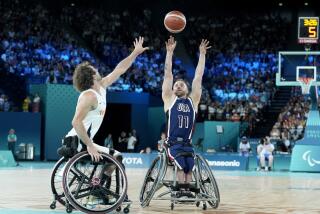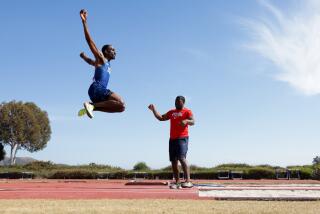Ski Mobility : Pierce Offers Adaptive Program That Makes Disabled ‘Feel Alive’
- Share via
WRIGHTWOOD — Doctors say what happened to Cathy Kim was the work of endorphins, a kind of super-drug secreted by the brain during periods of intense fear, pleasure or pain.
Kim thinks it had more to do with the wind and the snow.
Fact is, after returning from a ski trip for disabled people organized by Pierce College in Woodland Hills, she moved her arm for the first time in 25 years.
“I didn’t tell anyone,” said Kim, 27, who has been almost completely paralyzed since she fell off a swing at age 2 and struck her head on concrete, suffering brain damage.
“I wanted to be sure I could do it again.”
She can still move the arm, and has since developed the ability to lift her right foot several inches as well.
“It definitely had something to do with the skiing,” she said Friday, as she sat in the front seat of a bus headed to Mountain High Ski Resort in Wrightwood. “It makes you feel alive.”
“Adaptive” is the term for skiing tailored to the disabled. Pierce’s Adaptive Ski School is the only one of its kind in Los Angeles and one of few college-based adaptive ski programs in the country. For 20 years, it has provided modified ski equipment and trained instructors to guide the blind, the deaf, paralyzed people, amputees and others with disabilities, allowing them to experience the thrill of flying down snow-covered mountains.
Kim was joined on a recent Pierce-sponsored trip by an ex-mountain climber from Marina del Rey left partially crippled by oxygen deprivation, a blind man from Northridge, and a West Hills man who lost his left arm and leg in a motorcycle accident.
“Disabled people feel a freedom of movement when they’re moving down that hill that they don’t otherwise get to feel,” said Lynne Haile, a professor of physical education at Pierce and a ski school supervisor at Mountain High.
“Often, they ski just as gracefully as able-bodied people. It makes a tremendous difference to them, to get that mobility back.”
Due in part to the efforts of Haile--who raises all the funds for the program and organizes eight to 15 ski trips for the disabled each winter--Mountain High two years ago began encouraging its ski instructors to learn to work with disabled skiers.
There are 133 adaptive ski programs at resorts around the country, said Hal O’Leary, director of the National Sports Center for the Disabled at Winter Park in Colorado, one of the oldest and largest adaptive ski programs in the world. A year ago, there were only 75 such programs.
O’Leary said adaptive skiing “puts people in a position where they can be viewed as just a person, rather than a disabled person. When you’re wheeling around in a wheelchair, you’re a little different. But out on the hill, you’re the same as everyone out there trying to have fun.”
An increasing number of resorts are beginning to offer ski instruction for the disabled, he added. “Adaptive ski programs can bring a lot of attention to a ski resort. People look at them [resorts] as having a giving, caring attitude. They say, ‘Congrats, Bear Mountain,’ or ‘Way to go Heavenly!’ ”
Bear Mountain Ski Resort in Big Bear and Alpine Meadows at Lake Tahoe have the only two on-site, full-time adaptive ski programs in California, said KelLe Malkewitz, executive director of the California Adaptive Ski School at Big Bear.
But prodded by promoters of disabled skiing such as Haile, smaller resorts are also beginning to train instructors in the use of adaptive equipment such as sit-skis, (a shoe-shaped sled used by nonambulatory people), bi-skis, (two skis attached to a spring-like shock absorber, which is attached to a seat), and outriggers (small skis attached to crutches).
On a Pierce-sponsored outing on Friday, Kim zipped downhill in a sit-ski, with an instructor roped behind her, and another instructor trailing them, shielding them from faster skiers.
“I’ve been waiting for this all year,” she said. “The wind in your face, the snow covering your goggles . . . it’s taking a chance. I think everyone should try it.”
The ski trip she took last year did more for her than all of her 19 surgeries combined, she said.
“It gave me confidence,” she said. “I sat in my room after coming back, and I was looking at my arm, and something just kicked in. I said: ‘I’m going to move it. I’m not going to give up.’ I tried a new technique, concentrating on my shoulder, and it worked.”
A little higher up the mountain, Rusty Durham, 27, a blind man from Northridge, schussed down intermediate and advanced runs, turning, stopping and starting by listening to instructions from an instructor.
“The first time I went, it was a little bit scary and very exciting,” said Rusty, who began skiing with Pierce about eight years ago. Now, he helps train Mountain High instructors to teach blind people how to ski.
Few skiers or snowboarders at the resort seemed to notice the disabled skiers. In fact, a snowboarder slammed into Durham on one of his first runs down, only to be chewed out by Durham’s guide.
Dan Wilkins, 31, of West Hills, who lost his left arm and leg in a motorcycle accident, uses outriggers, including one attached to his left shoulder with a bungee cord and tape, to help balance himself.
Wilkins said skiing “is the only big thing that I really do. I don’t have any other hobbies. When winter comes around, it’s the only time I actually get outside and do something. It’s like the only time you’re in the mainstream.”
Steve Lefkowitz of Marina del Rey was brain-damaged by lack of oxygen at 18,600 feet while mountain climbing in the Argentine Andes 16 years ago. Lefkowitz now speaks slowly, and can’t walk without assistance. But standing on a pair of slightly modified skis, he darted down Mountain High’s difficult “Wyatt Earp” run--an icy, steep grade near the top of the mountain--without looking back.
“I ski better than I walk,” Lefkowitz said during a break. “I don’t need a lot of help, just a hand to get my skis back if they pop off. That’s where having a guide, and the support of a group, comes in handy.”
Lefkowitz said the Pierce program is unique for its low cost and accessibility. For $20, disabled participants in the program get a chartered bus ride, a lift ticket and the use of adaptive ski equipment.
After returning from Friday’s ski trip, Kim said she thought movement in her left hand had improved.
Doctors say her improvement comes from the release of endorphins--a neuro-peptide released by the brain to the nervous system when the body experiences intense pleasure or pain. “The theory is that endorphins can allow certain damaged nerve cells to heal themselves,” said Bernd Weiss, a professor of psychology at Pierce College who said he witnessed a dramatic change in Kim last year.
“From one semester to the next, she suddenly had an enormous amount of mobility in one arm,” Weiss said.
“I asked her if she had done anything unusual over the break. She said ‘Yes. I went skiing.’ ”
He is encouraging her to try skydiving. She’s interested.


